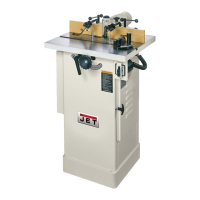4
• SECURE WORK. Use clamps or a vise to hold work when practical. It’s safer than using your hand
and it frees both hands to operate the tool.
• DON’T OVERREACH. Keep proper footing and balance at all times.
• MAINTAIN TOOLS WITH CARE. Keep tools sharp and clean for best and safest performance.
Follow instructions for lubricating and changing accessories.
• ALWAYS DISCONNECT THE MACHINE FROM THE POWER SOURCE BEFORE SERVICING.
• REDUCE THE RISK OF UNINTENTIONAL STARTING. Make sure the switch is in the off position
before plugging in.
• USE REOMMENDED ACCESSORIES. Consult the operator’s manual for recommended
accessories. The use of improper accessories may cause risk of injury to persons.
• NEVER STAND ON A MACHINE. Serious injury could occur if the machine tipped of if the blade is
unintentionally contacted.
• CHECK DAMAGED PARTS. Before further use of the machine, a guard or other part that is
damaged should be carefully checked to determine that it will operate properly and perform its
intended function - check for alignment of moving parts, binding of moving parts, breakage of parts,
mounting, and any other conditions that may affect its operation. A guard or other part that is
damaged should be properly repaired or replaced.
• DIRECTION OF FEED. Feed work into the cutter against the direction of rotation of the cutter only.
• NEVER LEAVE THE MACHINE RUNNING UNATTENDED. TURN POWER OFF. Don’t leave the
machine until it comes to a complete stop.
Volts Total Length of Cord in Feet
120V 25 50 100 150
240V 50 100 200 300
AWG
16 16 14 12

